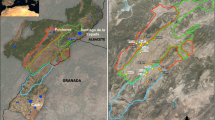Abstract
In this essay, I examine how Novella Carpenter, while paying dutiful homage to the American agrarian ideal, diverges from dominant agrarian discourse’s rural-centricity when she (trans)plants both the practice and the art of cultivation to an inner-city abandoned lot. In her memoir Farm City: The Education of an Urban Farmer (2009), Carpenter’s story of small family farming, indeed, evokes what Eric T. Freyfogle describes as an agrarian mode of life in which humans, as members of the land community, are “just as dependent as other life on the land’s fertility and just as shaped by its mysteries and possibilities” (Freyfogle, in: Freyfogle (ed) The new agrarianism: land, culture, and the community of life, Island Press, Washington, DC, 2001, p. xiii). Carpenter’s return to the city, however, marks a critical break from traditional understandings of agrarianism, challenging the city-country binary that has long been employed in the imagining of agrarianism. Farming in the city, like traditional agrarians she is attentive to the agencies of nonhuman entities and matters; unlike them, she moves beyond their rurality to reconfigure cities as agential bodies constantly in dynamic processes of becoming. In Farm City, her return from the land shifts the emphasis from the countryside to the city, evoking a “new agrarianism” that foregrounds both environmental stewardship and community-citizenship. The urban strain of Carpenter’s farming experience, I argue, not only brings to the fore the agronomic and spiritual potentialities of inner cities but forges a new ethical relation embracing humanity and history as active agents of the agrarian community.
Similar content being viewed by others
Notes
As Pollan puts it in his blurb to Farm City, Carpenter is an agrarian “going for a mind-meld of Fifty Cent and Wendell Barry, or an inner-city version of The Egg and I” (Pollan 2009, n. p.). In his review for the San Francisco Chronicle, Paul A. Smith similarly notes that Carpenter “ruminat[es] on the soft, agrarian sentimentality found in ‘Little House in the Big Woods’” (Smith 2009, p. J1). Dwight Garner of the New York Times, along this line, also accentuates Carpenter’s agrarian experience “[l]iving off the land” while comparing her popular women food writers who have been known for their “[f]resh, fearless, [and edgy]” attributes (Garner 2009, p. C32). Publishers Weekly also writes that Carpenter consistently “draw[s] on her Idaho ranch roots” and “chronicles the animals’ slaughter with grace and sensitivity, their cooking and consumption with a gastronome’s passion” (Editorial Review 2009, p. 43).
In Back to the Land, Brown identifies two waves of back-to-the-land movements in the US. The first back-to-the-land movement began in the 1890s with rapid industrialization and hence the shift of job opportunities to factories, and it culminated during World War I with the nation’s economic struggle. The second back-to-the-land movement began with the rapid urbanization and the worship for technology during the New Deal and ends in the late 1970s. While both generations share a faith in a rural future, the first back-to-the-landers envisioned a return to “artisanal skill, personal autonomy, and household self-sufficiency” (Brown 2011, p. 5) and the second generation were characterized by it “decentralist, regionalist, sometimes nostalgic” impulses (Brown 2011, p. 7).
Business entrepreneurship is a competing farm image of small-family farm economy deeply entrenched in the American psyche. For in-depth discussions of these two competing forces of American agriculture, see, most notably, Paul B. Thompson’s The Spirit of the Soil: Agriculture and Environmental Ethics (1995, pp. 47–71), and David B. Danbom’s “Past Visions of American Agriculture” in Visions of American Agriculture (1997, pp. 3–16).
For further debates on animal rights and the ethics of animal consumption, see, most notably, Peter Singer’s “Famine, Affluence, and Morality,” in Philosophy and Public Affairs 1 (Spring 1972), pp. 229–243, and John Arthur’s “World Hunger and Moral Obligation: The Case Against Singer,” in Steven M. Cahn (ed.), Exploring Ethics: An Introductory Anthology (Oxford: Oxford University Press, 2009), pp. 240–246.
References
Agnew, E. (2004). Back from the land: How young Americans went to nature in the 1970s, and why they came back. Chicago: Ivan R. Dee.
Brown, D. (2011). Back to the land: The enduring dream of self-sufficiency in modern America. Madison, WI: University of Wisconsin Press.
Carpenter, N. (2009). Farm city: The education of an urban farmer. New York: Penguin Books.
Cockrall-King, J. (2012). Food and the city: Urban agriculture and the new food revolution. Amherst, NY: Prometheus Books.
Danbom, D. B. (1997). Past visions of American agriculture. In W. Lockeretz (Ed.), Visions of American agriculture (pp. 3–16). Ames, IA: Iowa State University Press.
Editorial Review (2009). Review of Farm city: The education of an urban farmer, by Novella Carpenter. Publishers Weekly. 43.
Freyfogle, E. T. (2001). Introduction: A durable scale. In E. T. Freyfogle (Ed.), The new agrarianism: Land, culture, and the community of life (p. xiii). Washington, DC: Island Press.
Garner, D. (2009). Living off the land, surrounded by asphalt (p. C32). New York: New York Times.
Gifford, T. (2014). Pastoral, anti-pastoral, and post-pastoral. In L. Westling (Ed.), The Cambridge companion to literature and the environment (pp. 17–30). New York: Cambridge University Press.
Gramsci, A. (1971). Selections from the prison notebooks (trans: Hoare, Q., & Smith, G. N.). New York: International Publishers.
Iovino, S., & Oppermann, S. (2014). Introduction: Stories come to matter. In S. Iovino & S. Oppermann (Eds.), Material ecocriticism (pp. 1–17). Bloomington, IN: Indiana University Press.
Lockeretz, W. (1997). Preface. In W. Lockeretz (Ed.), Visions of American agriculture (pp. 2–8). Ames, IA: Iowa State University Press.
Nabhan, G. P. (2016). Agrarian ecology. In J. Adamson, W. A. Gleason, & D. N. Pellow (Eds.), Keywords for environmental studies (pp. 7–9). New York: New York University Press.
Nordahl, D. (2009). Public produce: The new urban agriculture. Washington, DC: Island Press.
Pollan, M. (2009). Blurb for Farm city: The education of an urban farmer, by Novella Carpenter. New York: Penguin Press.
Smith, P. A. (2009). Farm city by Novella Carpenter. San Francisco Chronicle. http://www.sfgate.com/books/article/Farm-City-by-Novella-Carpenter-3295154.php.
Thompson, P. B. (1995). The spirit of the soil: Agriculture and environmental ethics. London: Routledge.
United Nations, Department of Economic and Social Affairs, Population Division. (2014). World urbanization prospects: The 2014 revision, highlights. New York: United Nations.
Walbert, D. (2002). What’s a new agrarian? The new agrarian. Retrieved form http://www.newagrarian.com/whats-a-new-agrarian/.
Walbert, D. (2008). The eightfold agrarian way. The new agrarian. Retrieved form http://www.newagrarian.com/2008/05/the-eightfold-agrarian-way/.
Author information
Authors and Affiliations
Corresponding author
Rights and permissions
About this article
Cite this article
Chou, S.S. Back to the city: urban agriculture and the reimagining of agrarianism in Novella Carpenter’s Farm City . Neohelicon 44, 403–415 (2017). https://doi.org/10.1007/s11059-017-0402-0
Published:
Issue Date:
DOI: https://doi.org/10.1007/s11059-017-0402-0




